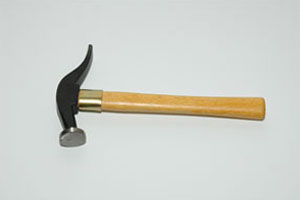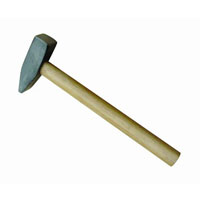 This tool is a massive metal blank, mounted on a handle, which is designed to strike the material or fasteners and create a short-term load of high force. Due to such a load, fasteners (dowels or nails) are driven in, or the material (metal) is bent. This tool is one of the most ancient of those invented by mankind and at present in hardware stores you can find hammers of the most diverse designs, designed for a variety of purposes. Below we want to give a classification of hammers, as well as give photographs of tools and their scope.
This tool is a massive metal blank, mounted on a handle, which is designed to strike the material or fasteners and create a short-term load of high force. Due to such a load, fasteners (dowels or nails) are driven in, or the material (metal) is bent. This tool is one of the most ancient of those invented by mankind and at present in hardware stores you can find hammers of the most diverse designs, designed for a variety of purposes. Below we want to give a classification of hammers, as well as give photographs of tools and their scope.
Types of hammers
1. Classic hammer. This hammer has a forged oblong metal head with a hole in the middle for mounting on a wooden handle. In modern hammers, the handle is sometimes made of metal and plastic. It is this metal part that affects the fasteners or material. If we consider this type of hammer more broadly, then it has two varieties:
- Sledgehammer. This is essentially a large hammer with a massive metal part, which is used in the manual dismantling of large tires or dismantling work. Detailed information about this tool can be found in the article " Sledgehammer Tool ".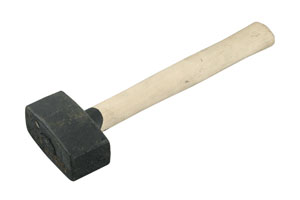
- Locksmith's hammer. This is exactly the classic type of hammer described at the very beginning.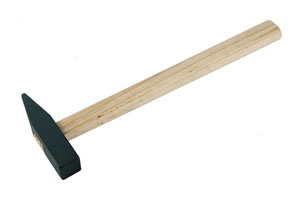 In this case, the head may have the form of a parallelepiped, with one of the sides having a smooth narrowing, or it may be rounded like a cylinder, also having a narrowing of one part.
In this case, the head may have the form of a parallelepiped, with one of the sides having a smooth narrowing, or it may be rounded like a cylinder, also having a narrowing of one part.
2. Carpenter's hammer. A feature of this type of hammers is that the length of the metal part is much greater than the thickness.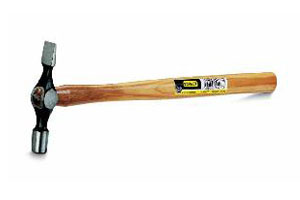 At the same time, the head of the hammer has a smooth striker on one side, and tapering on the other. The tapering edge of the metal part may or may not be flattened. With it, it is very convenient to hammer small thin carnations.
At the same time, the head of the hammer has a smooth striker on one side, and tapering on the other. The tapering edge of the metal part may or may not be flattened. With it, it is very convenient to hammer small thin carnations.
3. Hammer nail puller. This type of tool on one side of the metal part has a plane for driving nails, and on the other side a device for pulling nails. Details about this tool are described in the article " Nail puller ".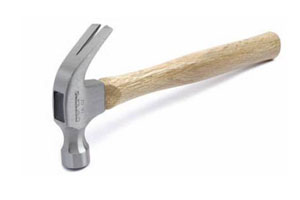
4. Mallet. This hammer is made of soft material.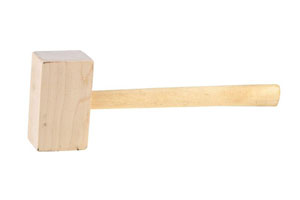 Usually it is made of wood, and the shock part is also made of wood or rubber. At the same time, the impact part is significantly larger in size than that of conventional hammers. This is due to the scope of their application. With the help of these hammers, metal materials of small thickness, such as tin or metal for roofing, are leveled. The massive impact part is made to increase the area of impact on the part, and the material of the hammer is chosen in order not to damage (not make a dent) the material. Also, mallets are used when hammering such a tool as a chisel or chisel into wood, so as not to break the handle of the hammered tool.
Usually it is made of wood, and the shock part is also made of wood or rubber. At the same time, the impact part is significantly larger in size than that of conventional hammers. This is due to the scope of their application. With the help of these hammers, metal materials of small thickness, such as tin or metal for roofing, are leveled. The massive impact part is made to increase the area of impact on the part, and the material of the hammer is chosen in order not to damage (not make a dent) the material. Also, mallets are used when hammering such a tool as a chisel or chisel into wood, so as not to break the handle of the hammered tool.
5. Hammer - pickaxe. Outwardly, this hammer resembles a nail hammer, but there is no slot for a nail on the thin part of the head.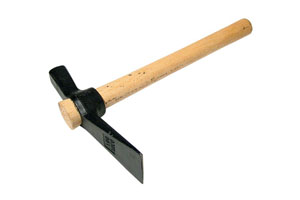 The thin part is flattened into a thin shoulder blade. This tool is mainly used by people who work with stone, tile and brick. This tool is very popular among archaeologists.
The thin part is flattened into a thin shoulder blade. This tool is mainly used by people who work with stone, tile and brick. This tool is very popular among archaeologists.
6. Shoemaker's hammer. The specified type of instrument has a peculiar appearance. On the one hand, it has a flat narrowing, in order to make it convenient to tear off the heel or sole. The shock part is somewhat expanded for more convenient driving of shoe nails.
